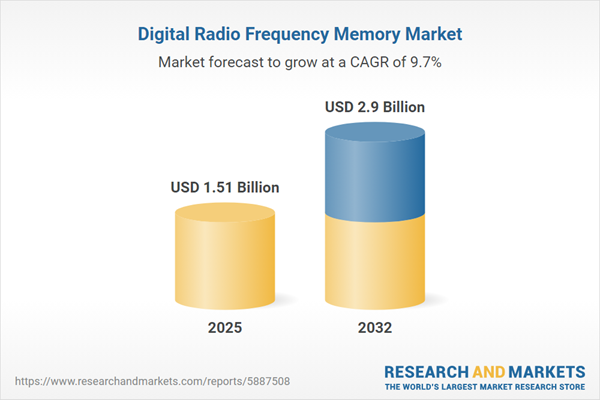Speak directly to the analyst to clarify any post sales queries you may have.
The digital radio frequency memory (DRFM) market is evolving as a pivotal enabler for senior decision-makers focused on secure communications, robust system resilience, and proactive modernization. Across global defense and telecommunications sectors, DRFM solutions are redefining standards for electronic infrastructure security and operational agility.
Market Snapshot: Digital Radio Frequency Memory Market Landscape
Worldwide, the DRFM market is registering steady growth and robust momentum, buoyed by tightening regulatory frameworks within the defense and communications industries. Organizations are adopting DRFM-based digital signal processing to strengthen electronic warfare capabilities and advance infrastructure safety. As digital transformation accelerates, the call for adaptable, cyber-resilient technologies is shaping procurement and investment strategies. Increasing reliance on DRFM platforms is driving innovation, supporting stringent compliance, and helping organizations sustain a competitive business model amid a shifting risk landscape.
Scope & Segmentation: Key Drivers and Market Segments
- Product Types: Fixed DRFM systems provide stable, high-efficiency performance for longstanding defense operations, while tunable DRFM modules deliver operational agility in dynamic environments where mission needs shift rapidly.
- Capacities: Compact, low-bit DRFM units are engineered for embedded and portable builds, maximizing space without sacrificing capability. High-bit DRFM systems cater to advanced applications demanding precise signal integrity and robust security, ensuring reliability in sensitive scenarios.
- Applications: Core uses include secure communications, real-time digital signal processing, and data management for high-complexity operations. DRFM is deployed in military environments, autonomous systems, and telecom platforms, where consistent and resilient performance is essential.
- End Users: Aerospace and defense agencies deploy DRFM to enhance combat system accuracy and bolster avionics safety. Automotive manufacturers are adopting DRFM for advanced vehicle connectivity, while consumer electronics companies implement it to reinforce device dependability. Telecom leaders utilize DRFM to maintain resilient and high-performance network infrastructures.
- Regions: The Americas spearhead market growth, fueled by ongoing defense system upgrades. EMEA places emphasis on cybersecurity improvements and infrastructure reliability. Asia-Pacific demonstrates agility through optimized manufacturing approaches, rapidly addressing changes in mobility technology and consumer electronics demand.
- Leading Companies: Firms such as Raytheon Technologies Corporation, Lockheed Martin Corporation, BAE Systems plc, Northrop Grumman Corporation, Leonardo S.p.A., Thales S.A., L3Harris Technologies, Inc., Saab AB, Elbit Systems Ltd., and HENSOLDT AG are actively engaged in research, development, and strategy to support DRFM market expansion and technology adoption.
Key Takeaways for Senior Decision-Makers
- DRFM systems are integral to effective threat monitoring, empowering organizations to respond proactively to emerging risks and adapt to new compliance requirements.
- Investing in advanced R&D initiatives accelerates the deployment of innovative DRFM platforms, helping retain relevance amid evolving technology trends.
- Modular and scalable DRFM architectures facilitate seamless adoption in new operational sectors, notably within the expanding fields of mobility and autonomous applications.
- Strategic planning is increasingly aligned with regional market dynamics, reflecting enhanced defense investments in the Americas and agile manufacturing in Asia-Pacific.
- Strengthening supplier relationships and refining procurement strategies help manage uncertainties associated with global supply and regulatory shifts.
- Continuous hardware and software upgrades ensure smooth DRFM integration, allowing organizations to sustain robust long-term positions within emerging electronic infrastructure markets.
Tariff Impact: Addressing Cost and Supply Chain Dynamics in 2025
Recent U.S. tariffs targeting semiconductor components have elevated DRFM production expenditures. Organizations are revising their sourcing strategies, deepening supplier partnerships, and improving integration workflows to assure ongoing system dependability. Regular assessment of evolving trade practices and commitment to proactive risk mitigation help safeguard operational continuity amid international policy changes.
Methodology & Data Sources
This report synthesizes perspectives gathered from executive interviews and industry specialists across the defense, automotive, electronics, and telecommunications domains. Data is further validated through regulatory disclosures, patent scans, and technical documentation to ensure an authoritative overview of the DRFM segment.
Why This Report Matters
- Guides organizations in developing forward-thinking strategies, bolstering electronic system resilience, and achieving a sustained competitive edge in high-technology markets.
- Clarifies complex compliance and regional regulatory shifts, preparing leaders to navigate uncertainty and plan with agility.
- Shows how DRFM technology strengthens next-generation digital infrastructure and ensures resilient, future-proof communications for sustained readiness.
Conclusion
Staying competitive in the DRFM market requires ongoing innovation and rapid alignment with changing operational and security demands. Senior leaders can advance technology objectives and secure organizational stability through informed investment and strategic adoption of DRFM solutions.
Additional Product Information:
- Purchase of this report includes 1 year online access with quarterly updates.
- This report can be updated on request. Please contact our Customer Experience team using the Ask a Question widget on our website.
Table of Contents
3. Executive Summary
4. Market Overview
7. Cumulative Impact of Artificial Intelligence 2025
Companies Mentioned
The companies profiled in this Digital Radio Frequency Memory market report include:- Raytheon Technologies Corporation
- Lockheed Martin Corporation
- BAE Systems plc
- Northrop Grumman Corporation
- Leonardo S.p.A.
- Thales S.A.
- L3Harris Technologies, Inc.
- Saab AB
- Elbit Systems Ltd.
- HENSOLDT AG
Table Information
| Report Attribute | Details |
|---|---|
| No. of Pages | 181 |
| Published | October 2025 |
| Forecast Period | 2025 - 2032 |
| Estimated Market Value ( USD | $ 1.51 Billion |
| Forecasted Market Value ( USD | $ 2.9 Billion |
| Compound Annual Growth Rate | 9.6% |
| Regions Covered | Global |
| No. of Companies Mentioned | 11 |









